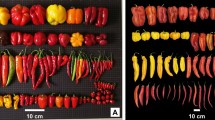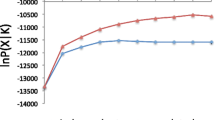Abstract
Understanding the extent and partitioning of crop genetic diversity is necessary for conserving and utilizing their genetic potentials for breeding. In the present study, fluorescence-labeled amplified fragment length polymorphism markers were used to characterize the genetic diversity and relationships of 79 cultivars and also of 122 F1 hybrids which resulted from six kiwifruit interploid crosses. A high level of mean genetic diversity was detected (Hj > 0.22) for all cultivars investigated, without significant differences among diploids (2x), tetraploids (4x), and hexaploids (6x). This suggested that no significant genetic erosion occurred in these cultivars, which were directly selected from natural resources or created from crosses. The Unweighted Pair Group Method with Arithmetic Mean analysis of the genetic dissimilarity between cultivars showed three main groups mostly based on their three ploidy levels. Among these, the red-fleshed cultivars which were originally derived from ‘Hongyang’ clustered into one subgroup of group I, suggesting their unique genetic background despite they were marked as different cultivars used in the current kiwifruit industry. By analyzing the genetic variation of hybrids with variable ploidy levels, our genetic analyses further revealed that interploid crosses can increase the genetic diversity of F1 offsprings, especially from the parental combinations of 6x–2x and 6x–4x, in which both parents showed significant differences in morphology and genetic backgrounds. Based on these findings, strategies were proposed for the conservation and utilization of the current kiwifruit genetic resources for future breeding programs.




Similar content being viewed by others
References
Adoukonou-Sagbadja H, Wagner C, Dansi A, Ahlemeyer J, Daïnou O, Akpagana K, Ordon F, Friedt W (2007) Genetic diversity and population differentiation of traditional fonio millet (Digitaria spp.) landraces from different agro-ecological zones of West Africa. Theor Appl Genet 115:917–931
Althoff DM, Gitzendanner MA, Segraves KA (2007) The utility of amplified fragment length polymorphisms in phylogenetics: a comparison of homology within and between genomes. Syst Biol 56:477–484
Beatson RA, Datson PM, Harris-Virgin PM, Graham LT (2007) Progress in the breeding of novel interspecific Actinidia hybrids. Acta Hortic 753:147–151
Belrose Inc (2013) World kiwifruit review, 2013th edn. Belrose, Pullman
Bonin A, Ehrich D, Manel S (2007) Statistical analysis of amplified fragment length polymorphism data: a toolbox for molecular ecologists and evolutionists. Mol Ecol 16:3737–3758
Brussaard L, Caron P, Campbell B, Lipper L, Mainka S, Mainka S, Rabbinge R, Babin D, Pulleman M (2010) Reconciling biodiversity conservation and food security: scientific challenges for a new agriculture. Curr Opin Env Sust 2(1):34–42
Chat J, Dumoulin PY (1997) Flow cytometry and RAPD markers applied to parentage analysis within Actinidia genus. Acta Hortic 444:109–111
Cheng CH, Seal AG, Boldingh HL, Marsh KB, MacRae EA, Murphy SJ, Ferguson AR (2004) Inheritance of taste characters and fruit size and number in a diploid Actinidia chinensis (kiwifruit) population. Euphytica 138:185–195
Collard BCY, Jahufer MZZ, Brouwer JB, Pang ECK (2005) An introduction to markers, quantitative trait loci (QTL) mapping and marker-assisted selection for crop improvement: the basic concepts. Euphytica 142:169–196
Dalirsefat SB, Meyer AS, Mirhoseini SZ (2009) Comparison of similarity coefficients used for cluster analysis with amplified fragment length polymorphism markers in the silkworm. Bombyx mori J Insect Sci J Insect Sci 9:1–8
Datson PM, Ferguson AR (2011) Actinidia. Wild crop relatives. In: Kole CD (ed) Wild crop relatives: genomic and breeding resources. Tropical and subtropical fruits. Springer, Heidelberg, pp 1–20
Dawson IK, Simons AJ, Waugh R, Powell W (1995) Diversity and genetic differentiation among subpopulations of Gliricidia sepium revealed by PCR-based assays. Heredity 75:10–18
Dice LR (1945) Measures of the amount of ecologic association between species. Ecology 26:297–302
Doyle JJ, Doyle JL (1987) A rapid DNA isolation procedure for small quantities of fresh leaf tissue. Phytochem Bull 19:11–15
Esquinas-Alcázar J (2005) Protecting crop genetic diversity for food security: political, ethical and technical challenges. Nat Rev Genet 6:946–953
Ferguson AR (2007) The need for characterisation and evaluation of germplasm: kiwifruit as an example. Euphytica 154(3):371–382
Ferguson AR, Huang HW (2007) Genetic resources of kiwifruit: domestication and breeding. Hortic Rev 33:1–121
Ferguson AR, Seal AG (2008) Kiwifruit. In: Hancock JF (ed) Temperate fruit crop breeding: germplasm to genomics. Springer, New York, pp 234–264
Frankham R (2010) Challenges and opportunities of genetic approaches to biological conservation. Biol Conserv 143:1919–1927
Gepts P (2006) Plant genetic resources conservation and utilization. Crop Sci 46(5):2278–2292
Glaszmann JC, Kilian B, Upadhyaya HD, Varshney RK (2010) Accessing genetic diversity for crop improvement. Curr Opin Plant Biol 13:167–173
Huang HW (2009) History of 100 years of domestication and improvement of kiwifruit and gene discovery from genetic introgressed populations in the wild. Chin Bull Bot 44:127–142
Huang HW (2013) Actinidia germplasm resources in China. China Forestry Publishing House, Beijing
Huang SX, Ding J, Deng DJ, Tang W, Sun HH et al (2013) Draft genome of the kiwifruit Actinidia chinensis. Nat Commun 4:2640. doi:10.1038/ncomms3640
Kalia RK, Rai MK, Kalia S, Singh R, Dhawan AK (2011) Microsatellites markers: an overview of the recent progress in plants. Euphytica 177:309–334
Kidwell KK, Bingham ET, Woodfield DR, Osborn TC (1994) Relationships among genetic distance, forage yield and heterozygosity in isogenic diploid and tetraploid alfalfa populations. Theor Appl Genet 89(2):323–328
Kokudo K, Beppu K, Kataoka I, Fukuda T, Mabuchi S, Suezawa K (2003) Phylogenetic classification of introduced and indigenous Actinidia in Japan and identification of interspecific hybrids using RAPD analysis. Acta Hortic 610:351–356
Korkovelos AE, Mavromatis AG, Huang WG, Hagidimitriou M, Giakoundis A, Goulas CK (2008) Effectiveness of SSR molecular markers in evaluating the phylogenetic relationships among eight Actinidia species. Sci Hortic 116:305–310
Lacerda DR, Acedo MDP, Lemos Filho JP, Lovato MB (2001) Genetic diversity and structure of natural populations of Plathymenia reticulata (Mimosoideae), a tropical tree from the Brazilian Cerrado. Mol Ecol 10:1143–1152
Lafitte HR, Courtois B (2002) Interpreting cultivar × environment interactions for yield in upland rice: assigning value to drought-adaptive traits. Crop Sci 42:1409–1420
Leitch AR, Leitch IJ (2008) Genomic plasticity and the diversity of polyploid plants. Science 320:481–483
Li DW (2010) The studies on ploidy variation, genetic diversity and introgression in Actinidia chinensis Planchon complex Dissertation. Wuhan Botanical Garden, Chinese Academy of Sciences
Li JQ, Li XW, Soejarto DD (2007) Actinidiaceae. In: Wu ZY, Raven PH, Hong DY (eds) Flora of China, vol 12. Science Press, Beijing, pp 334–362
Li DW, Zhong CH, Liu YF, Huang HW (2010a) Correlation between ploidy level and fruit characters of the main kiwifruit cultivars in China: implication for selection and improvement. NZ J Crop Hortic Sci 38:137–145
Li DW, Liu YF, Zhong CH, Huang HW (2010b) Morphological and cytotype variation of wild kiwifruit (Actinidia chinensis complex) along an altitudinal and longitudinal gradient in central-west China. Bot J Linn Soc 164:72–83
Liu YF, Liu YL, Huang HW (2010) Genetic variations and natural hybridization among sympatric Actinidia species and the implications for introgression breeding of kiwifruit. Tree Genet Genomes 6:801–813
Lynch M, Milligan BG (1994) Analysis of population genetic structure with RAPD markers. Mol Ecol 3:91–99
Messina R, Testolin R, Morgante M (1991) Isozymes for cultivar identification in kiwifruit. HortScience 26:899–902
Mizugami T, Kim JG, Beppu K, Fukuda T, Kataoka I (2007) Observation of parthenocarpy in Actinidia arguta selection ‘Issai’. Acta Hortic 753:199–203
Naval M, Zuriaga E, Pecchioli S, Llácer G, Giordani E, Badenes M (2010) Analysis of genetic diversity among persimmon cultivars using microsatellite markers. Tree Genet Genomes 6:677–687
Nei M, Li W (1979) Mathematical model for study genetic variation in terms of restriction endonucleases. Proc Natl Acad Sci U S A 74:5267–5273
Novo M, Romo S, Rey M, Prado MJ, González MV (2010) Identification and sequence characterization of molecular markers polymorphic between male kiwifruit (Actinidia chinensis var. deliciosa (A. Chev.) A. Chev.) accessions exhibiting different flowering time. Euphytica 175:109–121
Palombi MA, Damiano C (2002) Comparison between RAPD and SSR molecular markers in detecting genetic variations in kiwifruit (Actinidia deliciosa A. Chev.). Plant Cell Rep 20:1061–1066
Peakall R, Smouse PE (2006) Genalex 6: genetic analysis in Excel. Population genetic software for teaching and research. Mol EcolNotes 6:288–295
Pennington PD, Costa LM, Gutierrez-Marcos JF, Greenland AJ, Dickinson HG (2008) When genomes collide: aberrant seed development following maize interploid crosses. Ann Bot 101:833–843
Powell W, Morgante M, Andre C, Hanafey Mm Vogel J, Tingey S, Rafalski A (1996) The comparison of RFLP, RAPD, AFLP and SSR (microsatellite) markers for germplasm analysis. Mol Breed 2:225–238
Rohlf FJ (2000) NTSYS-pc: numerical taxonomy and multivariate analysis system. Version 2.1. Exeter Software, Setauket
Seal AG (2003) The plant breeding challenges to making kiwifruit a worldwide mainstream fresh fruit. Acta Hortic 610:75–80
Seal AG, Ferguson AR, de Silva HN, Zhang JL (2012) The effect of 2n gametes on sex ratios in Actinidia. Sex Plant Reprod 25:197–203
Shannon CE, Weaver W (1949) The mathematical theory of communication. University of Illinois Press, Urbana
Soltis PS, Soltis DE (2000) The role of genetic and genomic attributes in the success of polyploids. Proc Natl Acad Sci U S A 97:7051–7057
Soltis PM, Soltis DE (2009) The role of hybridization in plant speciation. Annu Rev Plant Biol 60:561–588
Stebbins GL (1950) Variation and evolution in plants. Columbia Univ Press, Columbia
Sui LY, Liu YF, Zhong CH, Huang HW (2013) Geographical distribution and morphological diversity of red-fleshed kiwifruit germplasm (Actinidia chinensis Planchon) in China. Genet Resour Crop 60:1873–1883
Udall JA, Wendel JF (2006) Polyploidy and crop improvement. Crop Sci 46:3–14
Vanneste JL (2012) Pseudomonas syringae pv. actinidiae(Psa): a threat to the New Zealand and global kiwifruit industry. N Z J Crop Hortic Sci 40:265–267
Vekemans X (2002) AFLP-SURV version 1.0. Distributed by the author. Laboratoire de Génétique et Ecologie Végétale, Université Libre de Bruxelles, Belgium
Wu JH, Ferguson AR, Murray BG (2011) Manipulation of ploidy for kiwifruit breeding: in vitro chromosome doubling in diploid Actinidia chinensis Planch. Plant Cell, Tissue Organ Cult 106:503–511
Wu JH, Ferguson AR, Murray BG, Jia Y, Datson PM, Zhang J (2012) Induced polyploidy dramatically increases the size and alters the shape of fruit in Actinidia chinensis. Ann Bot 109:169–179
Yan GJ, Ferguson AR, McNeilage MA, Murray BG (1997) Numerically unreduced (2n) gametes and sexual polyploidization in Actinidia. Euphytica 96:267–272
Yeh FC, Chong DKX, Yang RC (1995) RAPD variation within and among natural populations of trembling aspen (Populus tremuloides Michx.) from Alberta. J Hered 86:454–460
Zhang L, Li ZZ, Wang YC, Jiang ZW, Wang SM, Huang HW (2010) Vitamin C, flower color and ploidy variation of hybrids from a ploidy unbalanced Actinidia interspecifi ccross and SSR characterization. Euphytica 175:133–143
Zhang HL, Zhang DL, Wang MX, Sun JL, Qi YW, Li JJ, Wei XH, Han LZ, Qiu ZE, Tang SX, Li ZC (2011) A core collection and mini core collection of Oryza sativa L. in China. Theor Appl Genet 122(1):49–61
Zhao D, Yang J, Yang S, Kato K, Luo J (2014) Genetic diversity and domestication origin of tea plant Camellia taliensis (Theaceae) as revealed by microsatellite markers. BMC Plant Bio. doi:10.1186/1471-2229-14-14
Zhe Y, Lauer JG, Borges R, de Leon N (2010) Effects of genotype x environment interaction on agronomic traits in soybean. Crop Sci 50:696–702
Zhen YQ, Li ZZ, Huang HW (2004) Molecular characterization of kiwifruit (Actinidia) cultivars and selections using SSR markers. J Am Soc Hortic Sci 129:374–382
Zhivotovsky LA (1999) Estimating population structure in diploids with multilocus dominant DNA markers. Mol Ecol 8:907–913
Zhu SP, Song JK, Hu ZY, Tan B, Xie ZZ, Yi HL, Deng XX (2009) Ploidy variation and genetic composition of open pollinated triploid citrus progenies. Bot Stud 50:319–324
Acknowledgments
We would like to thank Fei Han and Xiaoli Liu for help with crossing experiments and cultivation, and Siping Li for experiments. This project was funded by NSF of China grant (Y211121N01).
Data archiving statement
We followed the standard Tree Genetics and Genomes policy. The marker information has been listed in Table 4 of the Appendix
Author information
Authors and Affiliations
Corresponding author
Additional information
Communicated by R. Burdon
Appendix
Appendix
Rights and permissions
About this article
Cite this article
Li, D., Liu, Y., Li, X. et al. Genetic diversity in kiwifruit polyploid complexes: insights into cultivar evaluation, conservation, and utilization. Tree Genetics & Genomes 10, 1451–1463 (2014). https://doi.org/10.1007/s11295-014-0773-6
Received:
Revised:
Accepted:
Published:
Issue Date:
DOI: https://doi.org/10.1007/s11295-014-0773-6




